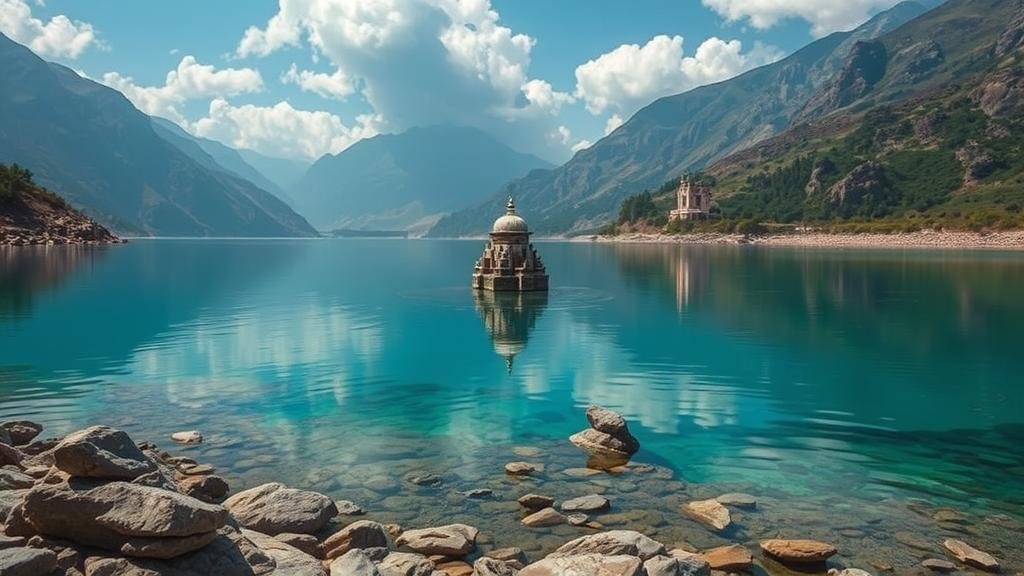Searching for the “Lake of Hidden Temples,” a submerged sacred site rumored in the Himalayas.
Searching for the Lake of Hidden Temples: A Submerged Sacred Site in the Himalayas
The Lake of Hidden Temples is more than a myth; it is a compelling legend that draws adventurers and historians alike to the heights of the Himalayas. This submerged sacred site, believed to be a reservoir of ancient spiritual relics, presents a fascinating intersection of history, culture, and the natural world. Located somewhere in the remote Himalayan regions of India and Nepal, the lake is said to house relics of temples dating back centuries, hidden beneath its tranquil surface.
The Legend and Its Origins
The tale of the Lake of Hidden Temples is steeped in local folklore. According to the narratives passed down through generations, this lake was once home to a prosperous civilization that practiced a unique spiritual tradition. Archaeologists and local historians suggest that the temples submerged beneath the lake may date back to the 8th century, coinciding with the rise of Buddhism and Hinduism in the region.
The region surrounding the lake is often described as ethereal, with dense forests, rugged mountains, and a serene atmosphere that enhances the allure of its hidden treasures. It is believed that a catastrophic event led to the flooding and subsequent submersion of these sacred structures. Some speculate that this event could have been a natural disaster, like an avalanche or a landslide, causing water levels to rise dramatically.
Geographical Context
Geographically, the Lake of Hidden Temples is thought to be located in the northern province of Uttarakhand, India, near the borders of Tibet. Uttarakhand is no stranger to legends; it is often referred to as Dev Bhoomi (Land of the Gods) due to its rich tapestry of temples and pilgrimage sites.
The lake itself is often described as an exquisite high-altitude body of water, surrounded by towering peaks, making access challenging. The recent advent of satellite imagery has helped researchers narrow down potential locations, though no confirmed exploration has yet taken place.
Scientific Exploration and Challenges
The search for the Lake of Hidden Temples presents a conundrum that combines history with scientific curiosity. Initial explorations have been hampered by treacherous weather conditions and the remoteness of the location. But, advancements in technology, such as remote sensing and underwater drones, provide hope for a successful expedition in the near future.
- Remote Sensing Technology: This allows scientists to map underwater environments without direct physical interaction.
- Underwater Drones: Equipped with cameras and sonar, these devices can explore submerged regions efficiently.
These technologies can significantly increase the chances of discovering remnants of the rumored temples, allowing researchers to analyze historical artifacts without disturbing the delicate ecosystem that has developed around the submerged site.
Real-World Applications and Implications
The pursuit of the Lake of Hidden Temples has broader implications for archaeology, anthropology, and even climate studies. Discovering the submerged structures may shed light on ancient technologies, religious practices, and social structures of Himalayan civilizations. For example, the architectural styles could indicate influences from neighboring cultures, thereby enriching our understanding of historical interactions.
Also, the investigations into how communities adapted to climate changes over centuries can provide insights into current ecological challenges faced globally due to climate change.
Actionable Takeaways
For those interested in exploring the mysteries of the Lake of Hidden Temples, several steps can be taken:
- Stay informed about ongoing archaeological projects in the Himalayas through social media and academic journals.
- Consider participating in guided treks or expeditions focusing on cultural heritage in the region.
- Support conservation efforts aimed at safeguarding this areas historical and ecological integrity.
To wrap up, the search for the Lake of Hidden Temples encapsulates the spirit of discovery, combining myth with scientific inquiry. As we continue to explore these enigmatic regions, we not only seek to unearth the past but also gain better insight into the intricate tapestry of human civilization.



